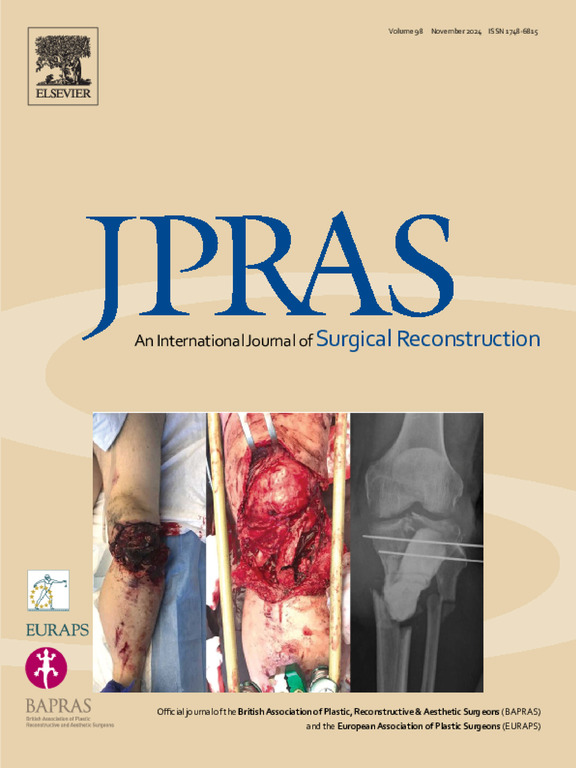Bacteriology of non-oncologic post-operative breast infections: A retrospective cross-sectional study to guide empiric antibiotic coverage
IF 2.4
3区 医学
Q2 SURGERY
Journal of Plastic Reconstructive and Aesthetic Surgery
Pub Date : 2025-08-22
DOI:10.1016/j.bjps.2025.08.021
引用次数: 0
Abstract
Background
Antibiotic prophylaxis for non-oncologic breast surgeries is not well described by procedure type. This study identified the underlying microbiological etiologies and antibiotic sensitivities of culture-positive infections from non-oncologic breast surgeries that were performed at a major medical center to guide specific empiric antibiotic coverage.
Methods
A retrospective cohort study was conducted at a tertiary hospital from November 2018 to January 2024. Patients aged ≥18 years who underwent non-oncologic breast surgery with culture-confirmed infections were included. Procedures analyzed included mastopexy, augmentation, reduction, gender-affirming surgery, and prophylactic mastectomies with and without reconstruction. Organism profiles from the procedures with >1 culture-positive infection were compared with their antibiogram to guide empiric treatment.
Results
Among the 3457 non-oncologic breast procedures, 37 resulted in culture-positive infections (1.07%). Infected patients were older (mean age 44 vs 37 years, p<0.05), but no significant differences in sex, body mass index, tobacco use, or comorbidities were noted. Infection rates were similar between prosthetic (1.04%) and non-prosthetic (1.08%) procedures (p=0.94) but were significantly higher in the risk-reducing mastectomy cohort (3.65% vs 0.92%, p<0.01). Organism profiles varied with the procedure. Organisms isolated from all procedures were sensitive to vancomycin. Empiric treatment recommendations included vancomycin plus ciprofloxacin, piperacillin-tazobactam, levofloxacin, or ceftazidime depending on the procedure type.
Conclusions
Microbial etiologies of surgical site infections following non-oncologic breast surgery differed with the procedure. Procedure-specific empiric antibiotic regimens may improve infection management. Institutional and regional antibiotic susceptibility should be investigated to inform clinical guidelines on antibiotic use.
非肿瘤性术后乳房感染的细菌学:一项指导经验性抗生素覆盖的回顾性横断面研究
背景:非肿瘤性乳房手术的抗生素预防并没有很好地描述手术类型。本研究确定了在主要医疗中心进行的非肿瘤性乳房手术中培养阳性感染的潜在微生物病因和抗生素敏感性,以指导特定的经验性抗生素覆盖。方法于2018年11月至2024年1月在某三级医院进行回顾性队列研究。年龄≥18岁、接受非肿瘤性乳房手术并经培养证实感染的患者被纳入研究。分析的手术包括乳房切除术、隆胸、缩小、性别确认手术和预防性乳房切除术,包括重建和不重建。将1培养阳性感染患者的微生物谱与其抗生素谱进行比较,以指导经验性治疗。结果3457例非肿瘤性乳房手术中,培养阳性感染37例(1.07%)。感染患者年龄较大(平均年龄44岁vs 37岁,p < 0.05),但在性别、体重指数、吸烟或合并症方面没有显著差异。假体手术(1.04%)和非假体手术(1.08%)的感染率相似(p=0.94),但在降低风险的乳房切除术队列中感染率明显更高(3.65% vs 0.92%, p= 0.01)。生物体的轮廓随手术过程而变化。所有方法分离的生物对万古霉素均敏感。经经验的治疗建议包括万古霉素加环丙沙星、哌拉西林-他唑巴坦、左氧氟沙星或头孢他啶,具体取决于手术类型。结论非肿瘤性乳房手术后手术部位感染的微生物病因因手术方式不同而不同。特定程序的经验性抗生素治疗方案可改善感染管理。应调查机构和地区的抗生素敏感性,以便为抗生素使用的临床指南提供信息。
本文章由计算机程序翻译,如有差异,请以英文原文为准。
求助全文
约1分钟内获得全文
求助全文
来源期刊
CiteScore
3.10
自引率
11.10%
发文量
578
审稿时长
3.5 months
期刊介绍:
JPRAS An International Journal of Surgical Reconstruction is one of the world''s leading international journals, covering all the reconstructive and aesthetic aspects of plastic surgery.
The journal presents the latest surgical procedures with audit and outcome studies of new and established techniques in plastic surgery including: cleft lip and palate and other heads and neck surgery, hand surgery, lower limb trauma, burns, skin cancer, breast surgery and aesthetic surgery.

 求助内容:
求助内容: 应助结果提醒方式:
应助结果提醒方式:


